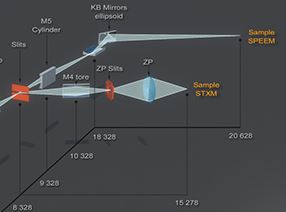The HERMES beamline (for High Efficiency and Resolution Beamline dedicated to X-ray Microscopy and Electron Spectroscopy) built at the synchrotron facility SOLEIL emerged to combine two complementary microscopic techniques (XPEEM and STXM) within a spatial resolution below 20 nm on an energy range from 70eV to 2,5 keV.
The HERMES beamline has been designed and optimized to deliver a high photon flux while assuring an energetic resolution sufficient to conduct both imaging and local spectroscopy studies. In order to permit the microscopes’ functioning on the wide energy range covered by the beamline, and then to fit with the specific requirements of each microscopes regarding the beam size, two configurations have been developed, depending on the energy range and the functioning mode:
Two undulators are used to cover the low (HU64) and high (HU42) energy range of the beamline. Three mirrors are located downstream the undulators and work by pair (M1A-M1B and M1A-M1C to respectively cover low and high energies). Each mirror couple has its specific incidence angle (2.5° and 1.2°), thereby ensuring a high reflectivity and a better high harmonic rejection.
The plane-grating monochromator includes two types of gratings, one for each functioning mode. In addition to selecting the energy, it allows to adapt the beam size to experimental needs (in terms of coherence and illumination).

Figure: Optics of the HERMES beamline
Special efforts have been dedicated to overcome some limiting problems usually encountered of soft X-ray beamline, such as:
This strategy happens to be fruitful since the contamination carbon impact of water-window measurements has been significantly reduced.
The commissioning step of the beamline is now over and showed that every specification expected has been reached. Thereby, monochromatic photon flux higher than 1013 photons per second and resolving power upper 104 were obtained. The remarkable beamline specificities should allow soft X-ray microscopy measurements with high vacuum resolution (<20nm).
- Spectral purity, which is generally limited by the ondulator’s high harmonics contamination. The chicane mode used by the three mirrors setup, combined with the high incidence angle (2.5°) allows a large contribution of the second harmonic (which is the most limiting one in the beamline energy range) of the HU64 undulator to be rejected. Besides, in order to improve the rejection (below 1%), the designers followed a development made by the optics group of SOLEIL and used two gratings especially designed to ensure high harmonic rejection (VGD: Variable Groove Depth). On this device, the groove depth is not uniform over the width of the gratings (see Lagarde et al. 2013[1]). At a given energy, the choice of the groove depth permits the harmonic rejection to be optimized for this specific energy.
- Optics carbon contamination. The energy range used by the HERMES beamline contains the so-called water-window (280-530 eV) and is then submitted to carbon contamination, which is an important limit to absorption measurements. Various procedures have been developed during the construction of the beamline to reduce carbon contamination of the optics:
- All the optical vacuum chambers are exclusively made with aluminum instead of stainless steel chambers.
- Whenever possible, the use of in-vacuum motors and encoders in most of the optical UHV chambers has been avoided.
- Water cooling systems with SiC substrate have been preferred to cryo-cooling, since the latter is known to be responsible for an enhancement of the CHx/COx cracking on metallic surfaces.
This strategy happens to be fruitful since the contamination carbon impact of water-window measurements has been significantly reduced.
The commissioning step of the beamline is now over and showed that every specification expected has been reached. Thereby, monochromatic photon flux higher than 1013 photons per second and resolving power upper 104 were obtained. The remarkable beamline specificities should allow soft X-ray microscopy measurements with high vacuum resolution (<20nm).
